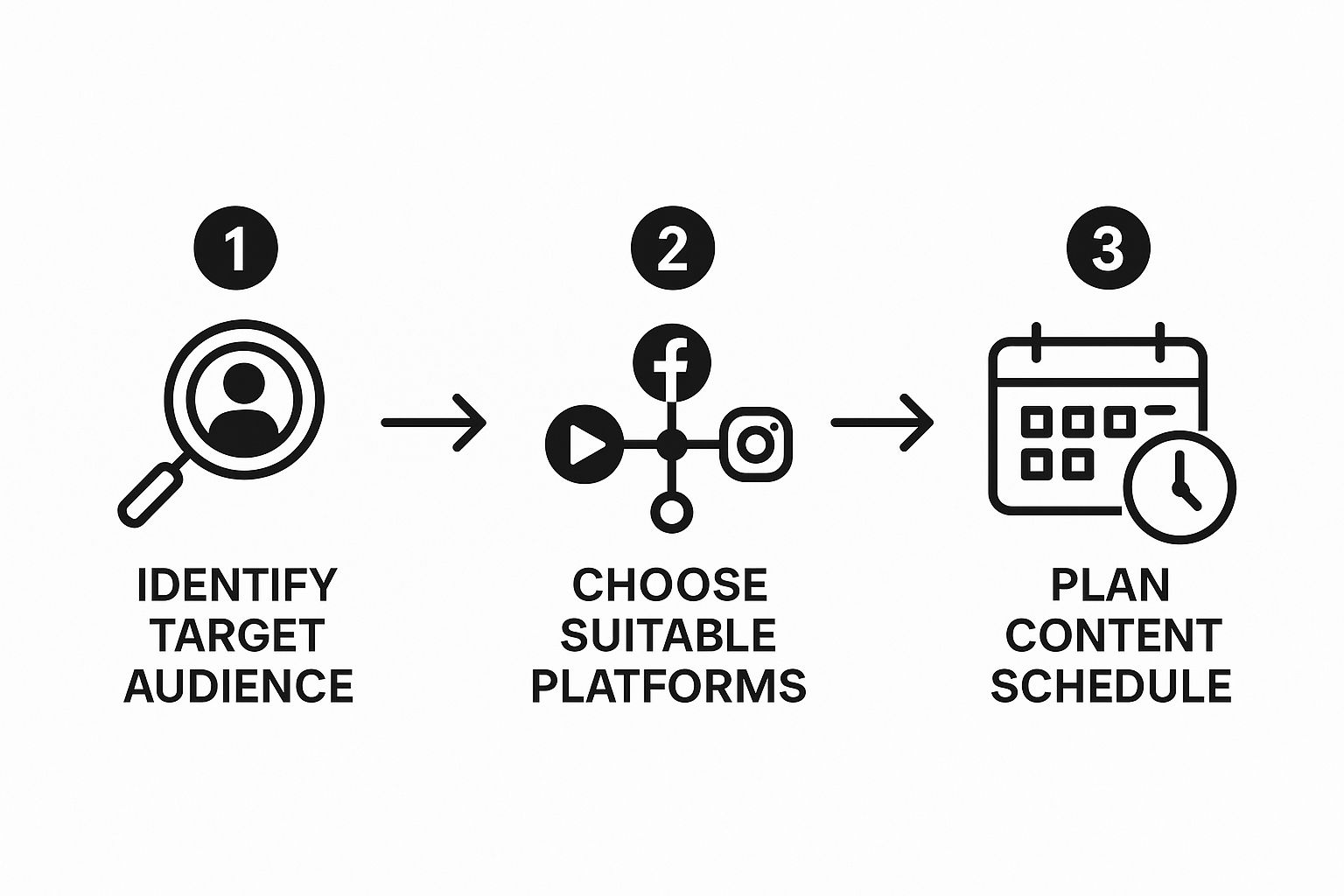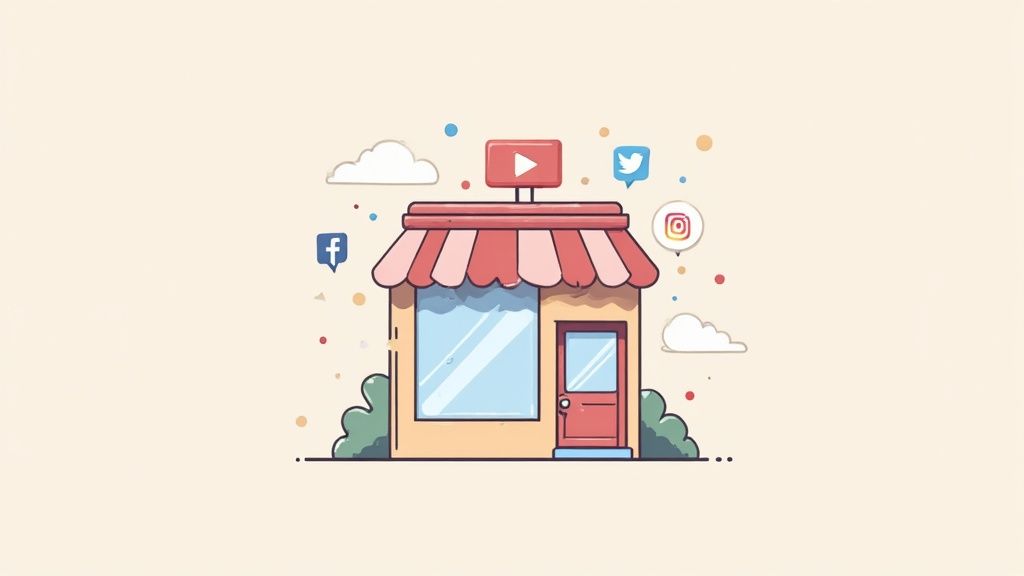If you're handling social media for a small business, you know it's about more than just throwing posts out there and hoping for the best. It’s about building a real, purposeful plan—defining who you're talking to, picking the right places to have those conversations, and creating content that actually resonates. At its heart, smart social media management is all about strategy, not just random activity.
Build a Social Strategy That Actually Works
Jumping on social media without a strategy is like setting sail without a map. You'll definitely be busy, but you probably won't get where you want to go. Before you even draft your first post, the most important thing is to get clear on your purpose.
Let's forget about vanity metrics like likes and follower counts for a minute. What business results are you actually aiming for?
Maybe success for you means generating 50 qualified leads a month from LinkedIn. Or perhaps it's boosting sales from your Instagram shop by 15% this quarter. Setting these kinds of specific, measurable goals is what turns social media from a time-sink into a value-driver.
First, Know Your Goals and Your People
The first real step is getting laser-focused on who you're trying to reach. And I mean really reach them, not just targeting a broad demographic. You need to dig deeper than just age and location.
What keeps your ideal customer up at night? What are their biggest frustrations? What content would make them stop scrolling and think, "Wow, they get me"? Taking the time for finding your target audience with a structured approach is time well spent.
When you know exactly who you're talking to, every single post can be crafted with a clear purpose, speaking directly to the people who are most likely to become your customers.
Key Takeaway: Businesses with clearly defined goals are a staggering 376% more likely to report success from their social media efforts. This just goes to show how critical focused planning and measurement really are.
This whole process follows a logical flow, starting with the big picture and getting more specific as you go.

As you can see, moving from audience to platform to content is the most effective path. This structured approach is especially crucial for small businesses, where every minute and every dollar counts.
Speaking of efficiency, don't be afraid to lean on modern tools. A whopping 90% of businesses are already using AI to help with things like content creation and engagement. If you want to dive deeper into building a complete plan from the ground up, our guide on https://outbrand.design/blog/social-media-marketing-strategies-for-small-businesses is a great place to start. It's packed with strategies that can give you a real edge.
Create Content That Resonates and Connects

Alright, you’ve got your strategy mapped out. Now for the fun part: creating content that actually stops people from scrolling past. If you only remember one thing, let it be this: great social media isn't about selling. It's about starting a conversation and building a real connection.
To get this right, I've always found it helpful to think of content in terms of four key roles it can play. Balancing these ensures your feed is a place people want to visit, not just a digital billboard for your business.
The Four Pillars of Great Content
A truly effective social media feed is a healthy mix. If all you do is sell, people tune out. Fast. By rotating through these four types of content, you keep things fresh and build a relationship that makes people want to buy from you when the time is right.
- Educate: You're the expert, so share what you know! A local bakery could film a quick tip on keeping sourdough fresh. A financial advisor might post a checklist for tax season prep. This kind of content builds immense trust and makes you the first person they think of when they need help.
- Entertain: Don't be afraid to show your personality. Post a funny, relatable meme about the Monday morning struggle in your industry, or share a behind-the-scenes video of your team. People connect with people, and entertainment makes your brand feel human and memorable.
- Inspire: This is where you connect on an emotional level. Did a customer have a great experience? Ask their permission to share their story. Talk about why you started your business in the first place. This is how you build a tribe of loyal fans who believe in what you stand for.
- Convince: Okay, now you can sell—but gently. This is where you post that glowing five-star review, announce a flash sale, or show a demo of your product solving a real problem. When you've already provided value with the other three pillars, your audience will be far more receptive to these posts.
When you plan your content around this mix, you’re serving your audience first. That's the secret to making them listen when you finally ask for the sale.
Turning Happy Customers Into Your Best Marketers
Some of the most convincing content you'll ever have won't even be made by you. I'm talking about user-generated content (UGC)—the photos, videos, and reviews your customers share. It's pure marketing gold because it’s authentic social proof that new followers instinctively trust.
Think about it. A small boutique can run a contest asking customers to post photos with their new outfits using a unique hashtag. You can then reshare the best ones (always crediting the creator!). It’s a win-win: you get fantastic, real-world content, and your customers feel celebrated, which builds incredible loyalty.
A simple "Tag us to be featured!" in your Instagram bio or a note on your packaging is often all it takes to get the ball rolling. It's a low-effort, high-impact tactic that's perfect for any small business budget.
This approach is especially powerful with video. It's no secret that short-form video is dominating, with 78% of consumers saying it's their preferred way to discover new products. These quick, engaging clips are perfect for showcasing both your offerings and your happy customers, and they don't require a Hollywood budget to produce. If you want to dive deeper into the data, you can explore more by reviewing the latest social media statistics.
Streamline Your Workflow and Save Time

Let's be honest—as a small business owner, your time is your most precious commodity. Consistency is what wins on social media, but who has time to come up with something clever to post every single day? It’s exhausting.
The real secret isn’t working harder; it’s working smarter. You need an efficient, repeatable process for your content.
This is where content batching comes in. It’s a game-changer. Instead of that daily scramble, you block out a specific chunk of time—maybe a few hours one Friday a month—to plan, create, and schedule everything in one go. This simple switch frees up your brainpower for the rest of the month and keeps your social channels humming along while you focus on actually running your business.
Choosing the Right Tools for the Job
To make batching truly effective, you need a little help from technology. Social media management tools are built for this, letting you schedule posts across all your profiles from one central hub. They are an absolute must-have if you're serious about getting your time back.
You've got a few different types of tools to consider, depending on your needs and budget.
- Simple Schedulers: If you’re just starting out and only on Facebook and Instagram, something like Meta Business Suite is perfect. It’s free and handles the basics of scheduling and analytics.
- All-in-One Platforms: When you're ready for more power, tools like Hootsuite or Buffer offer scheduling for more platforms, deeper analytics, and features for team collaboration.
- AI-Powered Content Generation: For the ultimate in efficiency, platforms like OutBrand go a step beyond scheduling. They can help you generate an entire 30-day content calendar—complete with visuals and captions—all based on your brand’s unique voice and style.
The goal isn't just to schedule posts. It's to build a system. Using the right tool allows you to see your entire month at a glance, ensure you have a healthy mix of content, and maintain your brand voice without the daily grind.
Automate and Systemize Your Process
Once you've picked your tool, the next move is to build a reliable workflow around it. This is about creating a predictable process that you can count on week after week. If you want to really get into the nitty-gritty, our guide on how to automate social media posts is a great resource.
Here’s a practical tip: create a simple content library. Use something like Google Drive or Notion to store your best-performing posts, approved brand images, and caption templates.
That way, when it’s time to batch your content, you aren't staring at a blank screen. You’re pulling from a collection of proven assets, which makes the creative process incredibly fast. This is how you turn social media from a frantic daily task into a manageable and strategic part of your marketing. You get to stop the last-minute panic and take back control.
Engage Your Community and Build Real Relationships
Alright, you’ve planned your content and scheduled your posts. Now comes the part that truly separates successful brands from the rest: actually being social on social media. This isn't about broadcasting into a void; it’s about rolling up your sleeves and building a genuine community.
Think of it this way: social media is a two-way street, not a billboard. The most powerful thing you can do is show people you're listening. When someone comments or sends a DM, they're knocking on your door. Answering it quickly and personally—using their name, referencing their specific point—is how you start building real trust. It shows there's an actual human behind the logo, and that goes a long way.
Turn Every Interaction Into an Opportunity
Let's be honest, not every interaction will be a glowing review. But even negative feedback is a golden opportunity.
Imagine a customer complains on your Facebook page about a delayed order from your e-commerce shop. Your first instinct might be to delete it or get defensive. Don't. Instead, reply publicly with a genuine apology and a promise to make it right, asking them to send a DM with the details.
Suddenly, you've done more than just help one customer. You've shown everyone watching that you’re accountable and you care about service. You just turned a potential problem into a public display of your brand’s integrity. That’s a huge win.
The big takeaway here? Social media is about connection, not just promotion. When you actively engage with people—responding to comments, messages, and mentions—you create a loyal following that feels seen and valued.
Sparking Conversations That Matter
You can't just sit back and wait for the comments to roll in. You have to be the one to get the ball rolling. The good news is, this doesn't require a big budget, just a bit of creative thinking.
Here are a few things I’ve seen work wonders:
- Ask better questions. Don't just ask "Do you like our new product?" A local coffee shop could ask, "What’s the one coffee drink you absolutely can't start your day without and why?" This invites stories, not just one-word answers.
- Run simple, fun polls. Use Instagram Stories or Twitter polls to get your audience's opinion. A clothing boutique could let followers vote on which of two new dress designs to stock for the season. It’s an easy way to make them feel involved in your business decisions.
- Engage beyond your own profile. This is a big one. Spend 15 minutes every day just interacting with others. Leave thoughtful comments on your followers' posts or on content from other businesses in your niche. This builds goodwill and gets your name in front of entirely new, relevant audiences.
These small, consistent efforts are what truly build momentum. They show you're an active participant in the community, not just a business pushing for a sale. This is how you cultivate a base of customers who are not only ready to buy but are genuinely excited to support you.
Measure What Matters and Optimize for Growth

Here's a hard truth about social media marketing: if you aren't tracking your performance, you're just guessing. It’s that simple. And while it's incredibly easy to get lost in a sea of data, smart social media management is all about focusing on the metrics that actually move the needle for your business.
Let’s be honest, it's tempting to chase likes and followers. Seeing those numbers go up feels good. But your real objective isn't just to be popular; it's to see how your social media efforts translate into tangible business results. That means we need to look past the surface-level fluff and dig into the data that tells the real story.
From Vanity Metrics to Actionable Insights
The most successful small business owners I've worked with are absolutely ruthless about what they measure. They don't get sidetracked by numbers that look impressive but mean very little for their bottom line. Instead, they zoom in on the data points that reveal how their audience is actually behaving and whether that behavior is helping the business grow.
This requires a fundamental shift in perspective. You have to stop asking, "How many people liked this?" and start asking, "What did people do after seeing this?"
The answer to that second question is where the gold is.
What Should You Actually Track?
To get started, you don't need a PhD in data science. Just focus on a few key metrics that paint a clear picture of your performance.
Engagement Rate: This is the percentage of your audience that bothered to do something with your content—like, comment, share, or save. A high engagement rate is a strong signal that your content is hitting the mark and building a real community.
Click-Through Rate (CTR): This measures how many people actually clicked a link in your post to visit your website, a product page, or a blog. It’s a direct indicator of how well your content persuades people to take the next step.
Conversions: This is the big one. A conversion is when a user completes a specific, desired action, like signing up for your newsletter, downloading an ebook, or making a purchase. It’s the clearest evidence that your social media is generating real business value.
Tracking these numbers gives you a much clearer picture of what's working than just counting likes. To help you get started, here’s a quick-reference table of the most important metrics.
Essential Social Media Metrics to Track
| Metric |
What It Measures |
Why It's Important |
| Engagement Rate |
The percentage of your audience that interacted with a post. |
Indicates content resonance and community health. |
| Reach |
The unique number of people who saw your content. |
Shows the overall visibility and awareness of your brand. |
| Click-Through Rate (CTR) |
The percentage of viewers who clicked a link in your post. |
Measures how effective your content is at driving traffic. |
| Conversion Rate |
The percentage of visitors who took a desired action. |
Directly ties social media activity to business goals (sales, leads). |
| Cost Per Click (CPC) |
The amount you pay for each click on a social media ad. |
Helps you understand the cost-efficiency of your paid campaigns. |
| Return on Ad Spend (ROAS) |
The revenue generated for every dollar spent on ads. |
The ultimate measure of your advertising profitability. |
This table isn't exhaustive, but it's a solid foundation. Focus on mastering these before you get lost in more complex analytics.
Create a Monthly Analytics Routine
The good news is you don’t need fancy, expensive software to begin. Platforms like Instagram, Facebook, and LinkedIn all have powerful and free analytics dashboards built right into their business tools. The key is to actually use them.
Block out time on your calendar once a month for an "analytics day." Make it a non-negotiable appointment with your business. During this review, look for patterns. Which posts earned the most website clicks? What topics drove the most saves? Did that behind-the-scenes video lead to more DMs than your polished product shots?
A monthly review is your secret weapon. It's your chance to see what's hitting home so you can do more of it, and what's falling flat so you can cut your losses. This simple habit transforms your social media from a shot in the dark into a data-driven growth engine.
This analytical process is the heart of smart social media management. Once you understand which specific actions lead to the results you want, you can refine your entire strategy. For a deeper dive, our guide on measuring the ROI of social media marketing effectively offers a fantastic framework. This consistent review cycle is what ensures every minute you spend on social media is pushing your business forward.
Common Social Media Questions for Small Businesses
It’s completely normal to feel a bit lost when you first dive into social media for your business. You're not alone in these questions! Let’s walk through some of the most common hurdles I see small business owners face, and I'll give you some straightforward, practical advice from my own experience.
https://www.youtube.com/embed/elhhL6DhOzo
How Much Should I Be Posting Every Week?
Ah, the age-old "quality over quantity" question. Honestly, there's no single magic number that fits every business. I’ve seen businesses thrive with just a few great posts a week, while others struggle posting daily because the quality just isn't there.
A great starting point for most is 3-5 times per week on your main platform—wherever your audience hangs out most, like Instagram or Facebook. For your secondary channels, like LinkedIn or X (formerly Twitter), you can aim for 1-3 times per week.
The real secret weapon here is consistency. It’s far better to choose a schedule you can genuinely stick to without burning out. Your audience will learn when to expect content from you, which builds trust and anticipation.
Don’t fall into the trap of thinking you need to post every single day. A manageable schedule that delivers real value will always win against a frantic, inconsistent one. Your community will thank you for the reliability.
When Is the Best Time of Day to Post?
If I had a dollar for every time someone asked me this! You’ll see generic advice everywhere—"post at 9 AM on Tuesdays"—but that's usually a shot in the dark. The only "best" time to post is when your specific audience is online and ready to engage.
So, how do you find that sweet spot? The answer is hiding in your analytics.
- Go to the source: Dive into your native platform tools. Instagram Insights and Facebook Business Suite are goldmines of information. They will literally show you charts of the days and hours when your followers are most active.
- Test and measure: Pick the top two or three peak times and post consistently during those windows for a few weeks.
- Analyze the results: Check your post reach and engagement. The data will tell you what's working.
Think of it as an ongoing conversation with your audience, where you're constantly listening and adjusting.
How Do I Handle Negative Comments?
That feeling when you see a negative comment... it stinks. But before you hit delete, take a breath. Handled correctly, a negative comment can actually become a massive win for your brand. Unless it’s pure spam or truly offensive language, never just ignore or delete it.
Here’s a simple, professional playbook to turn things around:
- Respond Publicly and Quickly: Acknowledge their concern right there on the post. A simple, "We're so sorry to hear you had this experience," shows you're listening.
- Offer a Solution: Show you want to make it right. You're not just apologizing; you're taking action.
- Take It Offline: This is key. Ask them to send you a direct message with their details. This moves the sensitive part of the conversation to a private channel while showing everyone else you’re accountable.
This approach demonstrates incredible customer service. Everyone watching sees that you’re responsive and genuinely care, turning a potential PR crisis into a public display of your commitment.
Feeling buried under the never-ending need for fresh content? OutBrand can lift that weight. Our AI-powered platform generates a full 30-day, on-brand content calendar in minutes—complete with visuals and captions—so you can get back to what you do best. Get your professional content plan today.



